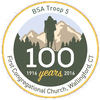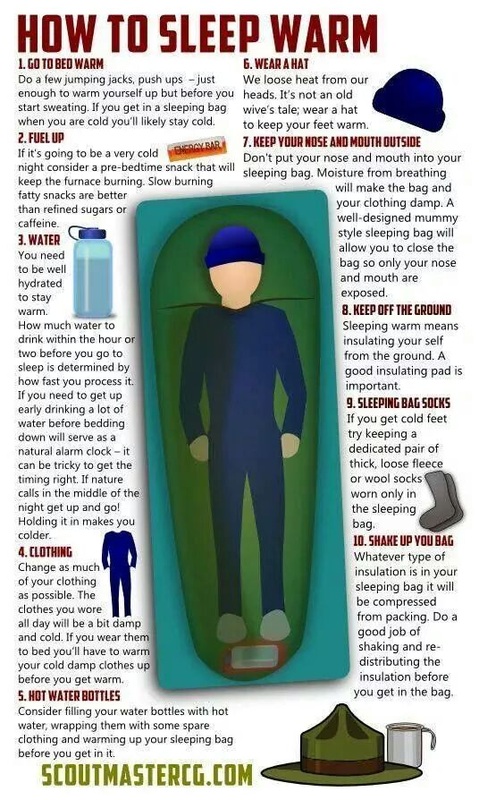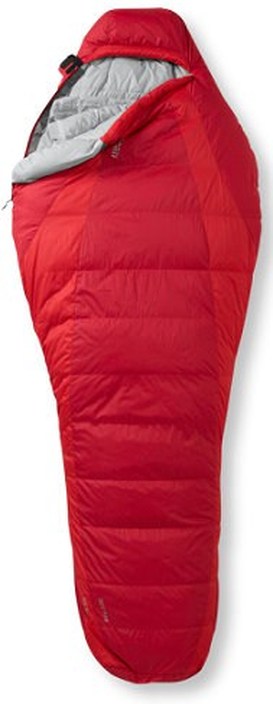Winter Camping
There are some questions about winter camping that scouts have and that lack of information causes them to be cold at night. Here is a page of tips that may help you stay warmer on those freezing campouts.
|
Winter Sleeping-System Hints:
Supper calories burn quickly on a cold evening. To avoid going to bed with an empty stomach and a chill, snack on high-calorie foods such as cheese, hard salami, or trail mix before turning in. Don't sleep in the clothes you've worn all day. Pack an extra pair of long underwear and socks for the night. You may feel warm and dry in the clothes you have worn all day, but they are full of moisture which will cool down as you sleep and you will wake up cold and damp. To help keep boots from freezing at night, put them in your stove or cook-kit bag and place under the foot of your sleeping bag. Contact lenses and solutions can go in your sleeping bag to keep them from freezing. Always wear a dry hat to bed. A balaclava is best because it covers your neck and ears. You lose 40% of your heat through your head. Take along an extra foam pad for insulation under your sleeping bag. Air mattresses provide no insulation from the cold ground. Use closed cell foam pad or Thermarest pad instead. To help keep cold air out of your sleeping bag when you roll over, take your down vest, sweater, or pile coat and lay it across your neck and chest, tuck it in so it acts like a collar. Keep your nose and mouth out of your sleeping bag because your breath is moist and will collect inside the bag to make you damp and cold. Wear a hooded sweatshirt or stocking cap and leave your face out of the bag. If it is very cold, wear a knit face mask. Sleep with boot liner, insoles, and socks inside your bag. Some people even sleep with their boots in their sleeping bags or place their boots under their feet between the bag and sleeping pad. I recommend putting boots in a stuff sack or bag first to prevent getting your equipment dirty. |
To reduce frost buildup while you're sleeping, keep your tent well ventilated, with the doors and windows open at least 3" to prevent a buildup of frost on the walls and ceiling from exhaled moisture.
Turn your water bottles upside down before going to bed. If water freezes, the ice will be on the bottom of the bottle when it's turned upright. If it's extremely cold, cuddle up with the bottles (filled with hot water) in your sleeping bag, but make sure they don't leak.
When going to bed everything should be put back in packs, NOTHING IS LEFT OUT. Nothing is more unpleasant than feeling around in four inches of new snow for cups, spoons, stoves, etc.
Sleep on extra clothes. Pad your contact points with extra padding.
Shoulders and hips deserve all the help they can get preserving heat. Put water bottle in your bag with you at night. It keeps it from freezing and provides needed relief from "Sahara Throat" in the morning. Also it provides starter water for melting snow for breakfast.
You've eaten a warm and calorie-laden meal, drunk a big mug of tea, and are feeling toasty. Then you crawl into a sleeping bag that may be 101 F or 20' F below zero. A lot of your body beat will now be lost heating your bag. Instead of losing calories in this way, boil a pot of water while dinner is being eaten and pour the boiling water into Nalgene water bottles. Screw the lids on tightly, check for leaks then put them in your sleeping
Go to the bathroom whenever you have to or else you are just keeping waste warm for no reason. Just before going to bed go to the bathroom and get up during the night too, if necessary. A more civil way of handling the business is to carry a one liter, wide mouth Nalgene bottle marked with a circle of duct tape so you can feel it in the dark and thus distinguish it from your water bottle. Urinate into the bottle, which with a little bit of practice can be done without getting out of the comfort of your sleeping
When going to bed visualize or think out exactly what you are going to do and where everything is that you'll need for the next morning. This will add tremendously to efficiency.
Pack down the snow in the area where you will pitch your tent to avoid an uneven surface under your sleeping pad. Never clear away the snow, as the ground underneath will begin to thaw and become muddy.
2/25/05
"Sleep & Shelter." Sleep & Shelter. N.p., n.d. Web. 06 Dec. 2014. <http://www.inquiry.net/OUTDOOR/winter/shelter/index.htm>.
Turn your water bottles upside down before going to bed. If water freezes, the ice will be on the bottom of the bottle when it's turned upright. If it's extremely cold, cuddle up with the bottles (filled with hot water) in your sleeping bag, but make sure they don't leak.
When going to bed everything should be put back in packs, NOTHING IS LEFT OUT. Nothing is more unpleasant than feeling around in four inches of new snow for cups, spoons, stoves, etc.
Sleep on extra clothes. Pad your contact points with extra padding.
Shoulders and hips deserve all the help they can get preserving heat. Put water bottle in your bag with you at night. It keeps it from freezing and provides needed relief from "Sahara Throat" in the morning. Also it provides starter water for melting snow for breakfast.
You've eaten a warm and calorie-laden meal, drunk a big mug of tea, and are feeling toasty. Then you crawl into a sleeping bag that may be 101 F or 20' F below zero. A lot of your body beat will now be lost heating your bag. Instead of losing calories in this way, boil a pot of water while dinner is being eaten and pour the boiling water into Nalgene water bottles. Screw the lids on tightly, check for leaks then put them in your sleeping
Go to the bathroom whenever you have to or else you are just keeping waste warm for no reason. Just before going to bed go to the bathroom and get up during the night too, if necessary. A more civil way of handling the business is to carry a one liter, wide mouth Nalgene bottle marked with a circle of duct tape so you can feel it in the dark and thus distinguish it from your water bottle. Urinate into the bottle, which with a little bit of practice can be done without getting out of the comfort of your sleeping
When going to bed visualize or think out exactly what you are going to do and where everything is that you'll need for the next morning. This will add tremendously to efficiency.
Pack down the snow in the area where you will pitch your tent to avoid an uneven surface under your sleeping pad. Never clear away the snow, as the ground underneath will begin to thaw and become muddy.
2/25/05
"Sleep & Shelter." Sleep & Shelter. N.p., n.d. Web. 06 Dec. 2014. <http://www.inquiry.net/OUTDOOR/winter/shelter/index.htm>.



